¿Necesita personalizar cómo se muestran los archivos de WordPress en la barra lateral?
El widget de archivos por defecto de WordPress ofrece una personalización limitada. Puede que desee que los archivos de sus entradas ocupen menos espacio, muestren más información o tengan un aspecto más atractivo.
En este artículo, le mostraremos cómo personalizar la visualización de los archivos de WordPress en su barra lateral.
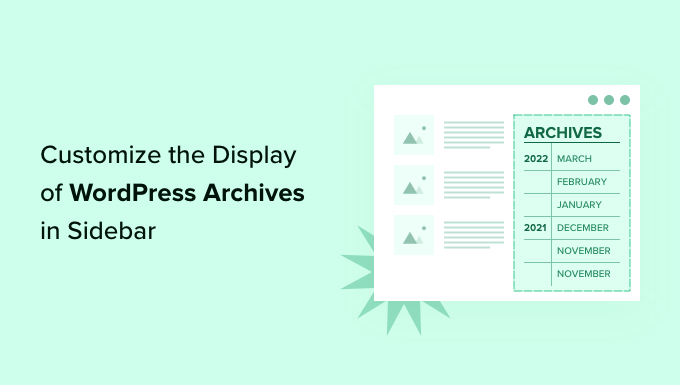
¿Por qué personalizar la visualización de los archivos de WordPress en la barra lateral?
Tu sitio web WordPress incluye un widget de archivos que te permite enlazar entradas mensuales de tu blog en una barra lateral.
El widget tiene dos opciones de personalización: puede mostrar la lista de archivos como un menú desplegable y puede mostrar el recuento de entradas de cada mes.
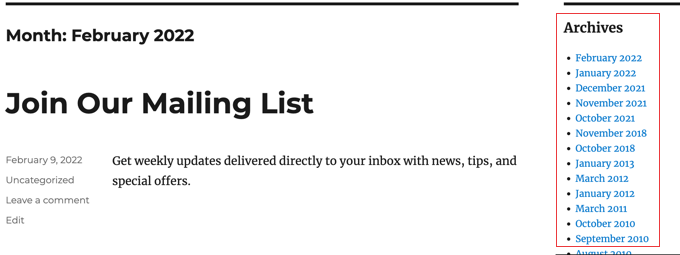
Sin embargo, es posible que desee mostrar su lista de archivo de la barra lateral de manera diferente. Por ejemplo, a medida que su sitio crece, la lista por defecto puede llegar a ser demasiado larga, o puede que desee hacer que sea más fácil para sus visitantes navegar.
Veamos algunas formas de personalizar la visualización de los archivos de WordPress en su barra lateral:
- Creación de archivos compactos
- Visualización de archivos en un esquema que se puede cerrar
- Limitación del número de meses de archivo mostrados
- Listar archivos diaria, semanal, mensual o anualmente
- Visualización de archivos mensuales ordenados por año
Creación de archivos compactos
Si su lista de archivos se ha hecho demasiado larga, puede crear un archivo compacto que muestre sus entradas utilizando mucho menos espacio.
Necesitarás instalar y activar el plugin Compact Archives, desarrollado y mantenido por el equipo de WPBeginner. Para más detalles, consulta nuestra guía paso a paso sobre cómo instalar un plugin de WordPress.
Una vez activado, puede añadir los archivos compactos a una entrada, página o widget utilizando el bloque ‘Archivos compactos de WPBeginner’.
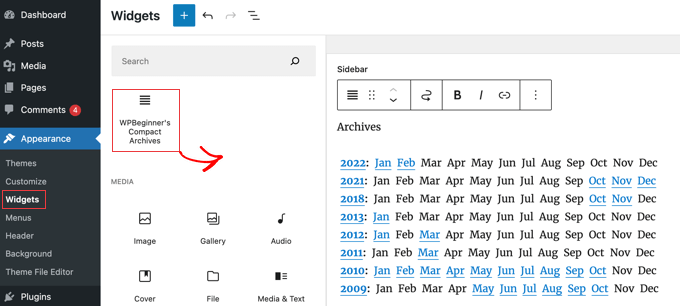
El anuncio / catálogo / ficha compacta ahorra espacio vertical al ser un poco más ancha. Eso significa que puede encajar mejor en un pie de página o en una página de archivos que en una barra lateral.
Sin embargo, el plugin es bastante configurable y puedes hacerlo más estrecho mostrando sólo la primera inicial o un número para cada mes. Puedes obtener más información en nuestra guía sobre cómo crear archivos compactos en WordPress.
Visualización de archivos en un esquema que se puede cerrar
Otra forma de gestionar las largas listas de archivos es mostrar un esquema desplegable de los años y meses en los que se publicaron entradas en el blog.
Para ello, debe instalar y activar el plugin Archivos compactos. Una vez activado, debes visitar la página Apariencia ” Widgets y añadir el widget ‘Archivos compactos’ a tu barra lateral.
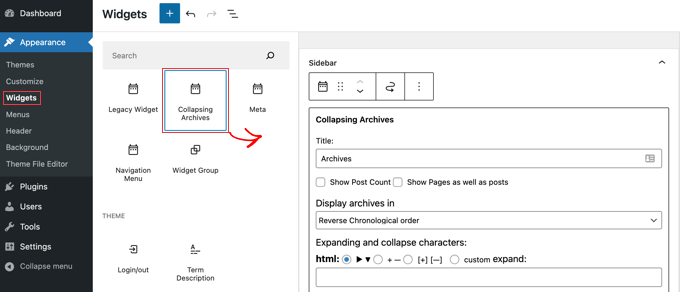
El widget Colapsar archivos utiliza JavaScript para cerrar su archivo por año. Los usuarios pueden hacer clic en los años para expandirlos y ver los archivos mensuales. Incluso puede hacer que los archivos mensuales se cierren y permitir a los usuarios ver los títulos de las entradas debajo.
Puede obtener más información consultando el Método 1 de nuestra guía sobre cómo limitar el número de meses de archivo mostrados en WordPress.
Así se ve en nuestro sitio web de demostración.
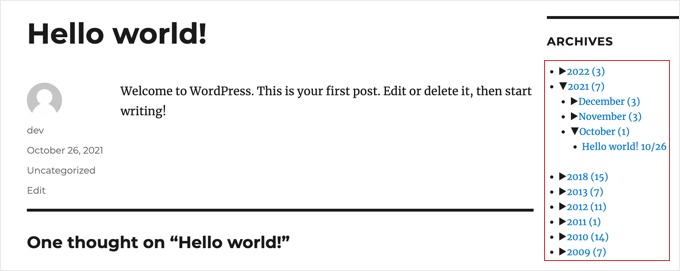
Limitar el número de meses de archivo mostrados
Una tercera forma de evitar que la lista de archivos sea demasiado larga es limitar el número de meses mostrados a, por ejemplo, los últimos seis meses.
Para ello, tendrás que añadir código a los archivos de tu tema de WordPress. Si no lo has hecho antes, consulta nuestra guía sobre cómo copiar y pegar código en WordPress.
El primer paso es añadir el siguiente fragmento de código a su archivo functions.php, en un plugin específico del sitio o utilizando un plugin de fragmentos de código.
// Function to get archives list with limited months
function wpb_limit_archives() {
$my_archives = wp_get_archives(array(
'type'=>'monthly',
'limit'=>6,
'echo'=>0
));
return $my_archives;
}
// Create a shortcode
add_shortcode('wpb_custom_archives', 'wpb_limit_archives');
// Enable shortcode execution in text widget
add_filter('widget_text', 'do_shortcode');
Puedes cambiar el número de meses mostrados editando el número en la línea 6. Por ejemplo, si cambia el número a “12”, se mostrarán 12 meses de archivos.
Ahora puedes ir a la página Apariencia ” Widgets y añadir un widget ‘HTML personalizado’ a tu barra lateral. Después, debes pegar el siguiente código en la caja del widget:
<ul>
[wpb_custom_archives]
</ul>

Al hacer clic en el botón “Actualizar”, su barra lateral mostrará sólo seis meses de archivos.
Para más detalles, consulte el método 3 de nuestra guía sobre cómo limitar el número de meses de archivo mostrados en WordPress.
Archivos de anuncios diarios, semanales, mensuales o anuales
Si quieres tener más control sobre cómo se listan tus archivos, el plugin Archivo anual te ayudará. Le permite listar sus archivos diaria, semanal, mensual, anual o alfabéticamente, y puede agrupar las listas por década.
Primeros pasos: instala y activa el plugin Archivo anual. Después de eso, puedes dirigirte a la página Apariencia ” Widgets y arrastrar el widget Archivo Anual a tu barra lateral.
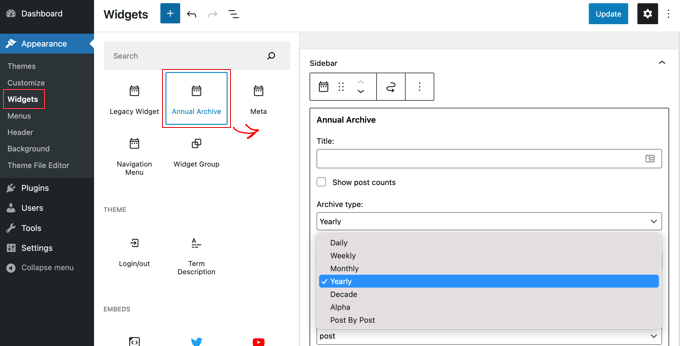
Puede dar un título al widget y seleccionar si desea mostrar una lista de días, semanas, meses, años, décadas o entradas. Puede desplazarse hasta otras opciones para limitar el número de archivos mostrados, elegir una opción de ordenación y añadir texto adicional.
Si navega hasta Ajustes ” Archivo anual, podrá personalizar aún más el listado del archivo utilizando CSS personalizado.
Visualización de archivos mensuales ordenados por años
Una vez estuvimos trabajando en el diseño del sitio de un cliente que necesitaba archivos mensuales ordenados por año en la barra lateral. Fue difícil de codificar porque el cliente solo quería mostrar el año una vez a la izquierda.
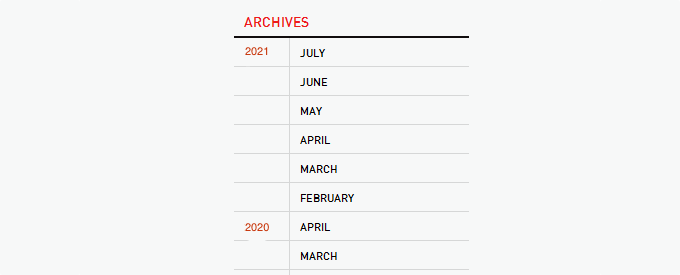
Hemos podido modificar un código de Andrew Appleton. El código de Andrew no tenía un parámetro de límite para los archivos, por lo que la ficha mostraba todos los meses de archivo. Hemos añadido un parámetro de límite que nos permite mostrar solo 18 meses en un momento dado.
Lo que tienes que hacer es pegar el siguiente código en el archivo sidebar.php de tu tema o en cualquier otro archivo donde quieras mostrar los archivos personalizados de WordPress:
<?php
global $wpdb;
$limit = 0;
$year_prev = null;
$months = $wpdb->get_results("SELECT DISTINCT MONTH( post_date ) AS month , YEAR( post_date ) AS year, COUNT( id ) as post_count FROM $wpdb->posts WHERE post_status = 'publish' and post_date <= now( ) and post_type = 'post' GROUP BY month , year ORDER BY post_date DESC");
foreach($months as $month) :
$year_current = $month->year;
if ($year_current != $year_prev){
if ($year_prev != null){?>
<?php } ?>
<li class="archive-year"><a href="<?php bloginfo('url') ?>/<?php echo $month->year; ?>/"><?php echo $month->year; ?></a></li>
<?php } ?>
<li><a href="<?php bloginfo('url') ?>/<?php echo $month->year; ?>/<?php echo date("m", mktime(0, 0, 0, $month->month, 1, $month->year)) ?>"><span class="archive-month"><?php echo date_i18n("F", mktime(0, 0, 0, $month->month, 1, $month->year)) ?></span></a></li>
<?php $year_prev = $year_current;
if(++$limit >= 18) { break; }
endforeach; ?>
Si desea cambiar el número de meses mostrados, entonces necesita editar la línea 19 donde el valor actual de $limit está establecido en 18.
También puede mostrar el número de entradas de cada mes añadiendo este fragmento de código en cualquier lugar entre las líneas 12-16 del código anterior:
<?php echo $month->post_count; ?>
Deberá utilizar CSS personalizado para mostrar correctamente el listado de archivos en su sitio web. El CSS que utilizamos en el sitio web de nuestro cliente tenía este aspecto:
.widget-archive{padding: 0 0 40px 0; float: left; width: 235px;}
.widget-archive ul {margin: 0;}
.widget-archive li {margin: 0; padding: 0;}
.widget-archive li a{ border-left: 1px solid #d6d7d7; padding: 5px 0 3px 10px; margin: 0 0 0 55px; display: block;}
li.archive-year{float: left; font-family: Helvetica, Arial, san-serif; padding: 5px 0 3px 10px; color:#ed1a1c;}
li.archive-year a{color:#ed1a1c; margin: 0; border: 0px; padding: 0;}
Esperamos que este tutorial te haya ayudado a aprender cómo personalizar la visualización de los archivos de WordPress en tu barra lateral. Puede que también quieras aprender a instalar Google Analytics en WordPress, o comprobar nuestra lista de formas probadas de ganar dinero blogueando con WordPress.
If you liked this article, then please subscribe to our YouTube Channel for WordPress video tutorials. You can also find us on Twitter and Facebook.





Syed Balkhi says
Hey WPBeginner readers,
Did you know you can win exciting prizes by commenting on WPBeginner?
Every month, our top blog commenters will win HUGE rewards, including premium WordPress plugin licenses and cash prizes.
You can get more details about the contest from here.
Start sharing your thoughts below to stand a chance to win!
AD says
Is there a way, or a widget of some kind, under the Archives sidebar to have blog posts by title displayed under under the correlating month; versus just the month alone being present that clicks into a new page displaying all posts for that month in their entirety?
I’m sorry if this has already been answered in the comments. I haven’t had a chance to read them.
Thank you for any help or direction you can provide my question!
WPBeginner Support says
Hello,
Please see our article on how to limit archives in WordPress.
Administrador
Jaswinder says
Thanks a lot for the code. Its a life saver.
Carla Izumi Bamford says
Thanks for this post, very helpful.
Margaret says
This was extremely helpful! Thank you so much. Did exactly what I needed it to.
Thomas says
Hello WPBEGINNER,
I hope you still have a look at this older post. First many thanks for this great tutorial and code.
I’ve managed to get
Year
January (2)
February (5)
…
…
But didn’t manage to count the posts per year. How can I do this, so that the year entry shows a number for all post for a year
year (28) …
Many thanks for your help!
Best regards,
Thomas
Erik says
Thanks so much for this code! it is helping me a lot.
it is helping me a lot.
Any chance to extend this to a specific category? by category id?
Jason Wofford says
The code is working perfectly but how can I add Days to each of the months?
Tony Lewis says
did not work for me seems to be missing some css
Xavier says
Is this code no longer working for anyone else out there??
James says
It does work at all !!!
result has nothing to do with example.
Strange that some guys felt it useful and great.
What is the issue ?
Eldad says
Just wanted to beem thanks
Xavier Bonet says
Hi! First thing’s first! Great code! Works perfectly! Thanks!
I was asking myself if there would be a way to edit the code in order to allow for the, say, 18-month span to move up or down according to what one is viewing? As is, you can only access the last 18 months. But perhaps there would be a way to do this so that when one opens up, for example, month 18 of the list, and the new page is opened, the archive list output by the code above sets month 18 as the middle of a new array showing, say, 9 months before and 7 after (or vice-versa).
Perhaps my explanation is not too clear. I got the idea when viewing this website here: http://marthabeck.com/. If you scroll down to the menu at the very bottom you will see there are several years available but only those months for the present year are displayed. When one opens up a new year, the months for that year are then displayed. Of course, this is probably another code entirely, but at least it works as a visual example of sort of what I’m talking about.
WPBeginner Support says
Try creating it with conditional tags on date based archives templates:
Look codex for is_archive single_month_title
Administrador
tobias says
Not the foreach() loop, the MySQL query should have a limit!
Jessica says
Is there a way for the archive be be daily or even weekly rather than just by month?
Editorial Staff says
You can use the calendar widget in WordPress.
Administrador
JP Lew says
I use a calendar, but in addition to that modified the code to output daily archives too, it worked great. Here’s the query:
$days = $wpdb->get_results(“SELECT DISTINCT DAY( post_date ) AS day , MONTH( post_date ) AS month , YEAR( post_date ) AS year, COUNT( id ) as post_count FROM $wpdb->posts WHERE post_status = ‘publish’ and post_date <= now( ) and post_type = 'lecture' GROUP BY day , month , year ORDER BY post_date ASC");
<a href="/year; ?>/month, 1, $day->year)) ?>/month, $day->day, $day->year)) ?>”>month, $day->day, $day->year)) . “, ” . date_i18n(“F”, mktime(0, 0, 0, $day->month, 1, $day->year)) . ” ” . date(“j”, mktime(0, 0, 0, $day->month, $day->day, $day->year)) . “, ” . $queried_year ?>post_count . “)”; ?>
//outputs: Thursday, August 22, 2013 (12)
Thanks for the post by the way, it was exactly what I was looking for. The performance is surprisingly good too.
JP Lew says
ok, your comment system stripped out all my `php` tags essentially rendering that code useless. Anyways, it’s possible and easy, you’ll figure it out.
Roelof says
Hello,
I like this idea. Can it also be adapted so only articles in a specific category will be in the archives and all the other categories not.
Roelof Wobben
Asher Charles says
Great little pice of code, been looking for a way to better display archives. Cheers
Carla says
I’ve looked everywhere for a tutorial on how to customize my archives page. I was able to get my page to produce a list of post titles and post dates, which is a great start. And now I need to figure out how to group them by month, so the page looks like this:
2013
May
This is a post title
May 28, 2013
And another post
May 20, 2013
I’m not really sure how to do this. Would you have any suggestions? I’ve noticed in the WordPress forum and elsewhere that lots of people want their archives to look like this, but they (like me) haven’t received any help.
Thank you!
Núria says
Thanks for this code snipped, it has been very usefull. I only want to add a little bit change that will make the output of the month’ string in the locale language.
On line 16 you can replace the date() function to date_i18n() function
– echo date(“F”, mktime(0, 0, 0, $month->month, 1, $month->year))
– echo date_i18n(“F”, mktime(0, 0, 0, $month->month, 1, $month->year))
Thus, the function will return for the march month the string “March” in English, “Marzo” in spanish or “Març” in catalan, only to put some examples, based on the language of the site.
Editorial Staff says
Thank you for this suggestion. Updated the code.
Administrador
Matt says
The theme I’m using has a widget for the sidbars. The php file is written in shortcode. How would I convert this to a shortcode to put into the file? Thanks.
Editorial Staff says
Take the first snippet and convert it into a function. Then use this article to create a shortcode:
https://www.wpbeginner.com/wp-tutorials/how-to-add-a-shortcode-in-wordpress/
Administrador
Ryan says
Hey,
I came across this, just what i was after. But it has a small problem, i have the last two months of posts october and november show in sidebar, i just added a new one in december and its not showing december in the archive list.
Weird why its not showing the current month
Editorial Staff says
That is indeed weird. We have this running fine on a client’s website.
Administrador
thao_ says
Is it possible to show the total years’ post_count, as well as the post_count for each month? So you’d still have each months’ post count next to each month, but also the total for the year next to the year. Using your archive image as the example, you’d have 2010 (20) and then the months as the currently display.
Editorial Staff says
Yes, you can add the counts of all the months in a year and display it if you want.
Administrador
craig coffman says
I think I got it sorted. I moved the “break;” up into the code before it spits out the monthly … . I figured it out after looking at Appleton’s site. His code is slightly different, as you noted. I find it interesting how people can change a single bit of code and the effect is wildly different from such a small edit. To borrow from WP, “Code is Poetry”
I did make one alteration which I wanted to bring to your attention. The above code did not seem to spit out the most current month. That is, my August month of this year would not appear (since we are now in August) but July showed just fine. I altered the SQL statement and now it does appear. I am not sure you want the current month, but if this is an archive perhaps even the current month is archived.
Here is my change:
post_date YEAR(CURDATE())
That seems to pull the month we are currently in. I am no SQL master, so perhaps there is a reason not to do this or even a better way. However it is working for me.
Thanks for your time on this tutorial. It definitely saved me from further bashing my head against a wall attempting to manipulate wp_get_archives().
craig coffman says
hmm… seems like some code was stripped out. There should be the Greater Than symbol in there, between “post_date” and “YEAR(CURDATE())”. Let me try again and I hope it takes.
post_date > YEAR(CURDATE())
Sorry for the additional post, but a ‘tweak’ doesn’t change anything if the proper code does not display
Ryan says
Hey Craig,
I am not sure where to put
post_date > YEAR(CURDATE())
Thanks
craig coffman says
Ryan –
Weird. I posted a response on the Float Left site but it does not seem to be there. Here is the file for you to download, showing where the code is located:
http://www.octoberland.com/fileChute/displayCurrentMonth.zip
I put the code in the index.php file from my template. It is there because the client wanted it to be on every page. It only grabs the current year’s months. That is, if you went back to 2011 the months displayed would still be 2012.
I added my code into the ‘WHERE’ line of the MySQL, replacing the code Andy had there.
Also, I have the standard WP archive function in there as well because my client wanted to display a yearly archive as well. This is not necessary for displaying the current month.
I hope this helps.
– Craig
Ryan says
Thank you craig, that seems to have fixed the issue.
craig coffman says
Ryan –
Happy it worked for you. It took me several hours (I am not a MySQL developer) to figure that out. Now that it is helped someone else, it was worth the effort
– Craig
mary says
how to display the days?
Editorial Staff says
You want to display all 30 days for all the months? Or do you just want to display the days? You might be better of using the built-in calendar widget.
Administrador
Akshat Goel says
Great post!! Saved my day!
zuzanka says
Hi, I’m using only widget, not extra plugin for archive. I limited number of months, e.g. 2 but I’m expecting to have 2 months and than the rest under “…” or “archive”. I can not find the way how to show the rest. Is here someone who knows this problem? Thanks a lot.
wpbeginner says
@sgclark That sounds good. Will have to test out his plugin and then add it in this article
sgclark says
@wpbeginner The unused months are wrapped in their own unique CSS class, so you can just do a CSS “display:none” for unused months. Then when a post appears in the month, it switches to a different class (via PHP)
wpbeginner says
@sgclark That plugin sounds good… Wonder how that would work if we don’t want to show the unused months at all. But nonetheless haven’t tried it yet because it is not hosted in the repository…
sgclark says
Justin Blanton created a neat WordPress plug in called SmartArchives. I am sure you could dig into his CSS file as well to play with the display and you don’t have to worry about all the extra code on the Sidebar PHP page. – http://hypertext.net/projects/smartarchives